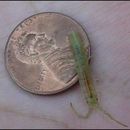Comprehensive Description
provided by Invertebrates of the Salish Sea
These isopods are narrow and elongate. They reach about 42 mm in length and have a telson with right lateral angles and an acute median spine. Colors of these isopods may vary and this may be due to the habitat in which they choose to live. The maxiilliped consists of 4 articles and the pleon consists of 2 free pleonites plus the pleotelson, which has a pair of lateral incisions indicating the posterior limits of another partly free pleonite.
- license
- cc-by-nc-sa
- copyright
- Rosario Beach Marine Laboratory
Look Alikes
provided by Invertebrates of the Salish Sea
How to Distinguish from Similar Species: They have a telson similar to Idotea stenops and the Idotea schmitti. However, I. fewkesi are far more narrow and elongated.
- license
- cc-by-nc-sa
- copyright
- Rosario Beach Marine Laboratory
Comprehensive Description
provided by Invertebrates of the Salish Sea
Biology/Natural History: Females appear to be ovigerous in July and October. Not much can be said about these subtidal isopods. Their pigmentation may be affected by the substrate on which they live.
- license
- cc-by-nc-sa
- copyright
- Rosario Beach Marine Laboratory
Habitat
provided by Invertebrates of the Salish Sea
Live on algae on exposed rocky coasts or subtidally.
- license
- cc-by-nc-sa
- copyright
- Rosario Beach Marine Laboratory
Distribution
provided by Invertebrates of the Salish Sea
Geographical Range: Alaska to central California
- license
- cc-by-nc-sa
- copyright
- Rosario Beach Marine Laboratory
Habitat
provided by Invertebrates of the Salish Sea
Depth Range: Commonly found in the subtidal zone although a few may be found in the intertidal zone.
- license
- cc-by-nc-sa
- copyright
- Rosario Beach Marine Laboratory

